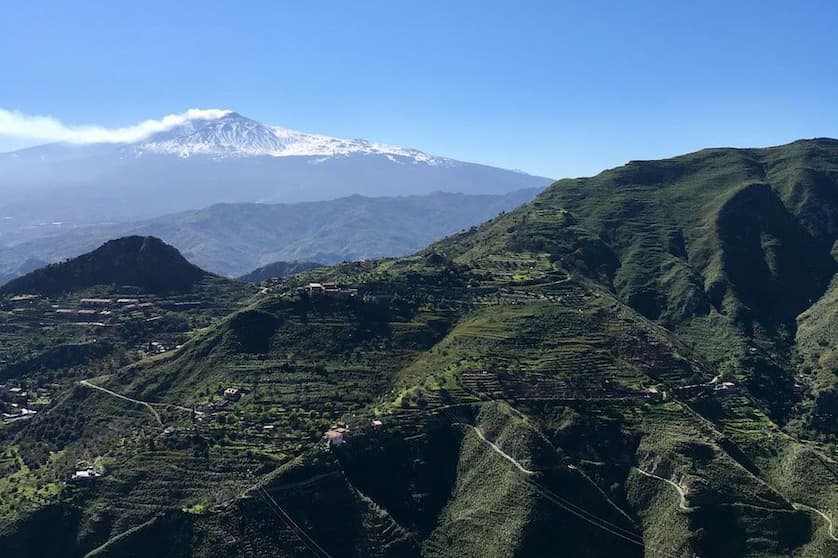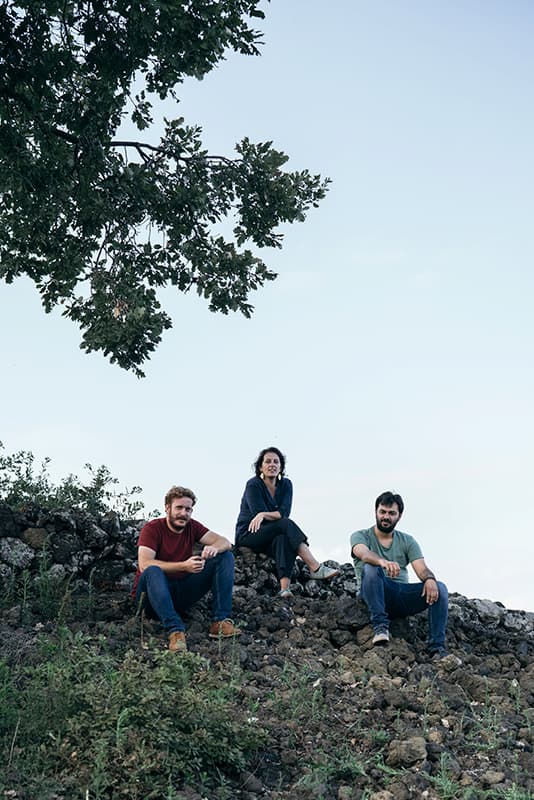From Camporeale to Etna: A Journey Through Sicilian Terroir

Join us as we explore two distinct faces of Sicily—sunlit inland hills and the volcanic slopes of Etna—through wines that speak of place, family, and a deep-rooted connection to the land.
Saturday 28th June
2.00pm-5.00pm
Open on the day:
2.00pm-5.00pm
Open on the day:
'23 Alessandro di Camporeale 'Benedè' Catarratto – $34
'23 Alessandro di Camporeale ‘Vigna di Mandranova’ Grillo – $40
'23 Alessandro di Camporeale ‘Vigna di Mandranova’ Grillo – $40
'21 Alessandro di Camporeale 'Kaid' Syrah – $55
'22 Generazione Alessandro Etna Bianco ‘Trainara’ Carricante/Catarratto – $65
'21 Generazione Alessandro Etna Rosso ‘Croceferro’ Nerello Mascalese – $65
'22 Generazione Alessandro Etna Bianco ‘Trainara’ Carricante/Catarratto – $65
'21 Generazione Alessandro Etna Rosso ‘Croceferro’ Nerello Mascalese – $65
Enjoy a 10% discount when you purchase any three bottles on the day.
Hosted by Mattia Bartolucci of Italian Wine Importers, and free of charge.

Sicily: The Crossroads of Wine and Civilisation
Sicily is Italy’s southernmost and most storied wine region—an island where culture, climate, and geology converge to produce wines of compelling character and identity. Just three kilometers from the mainland, but often feeling a world apart, Sicily has been shaped over millennia by waves of conquest and exchange. Its strategic location in the heart of the Mediterranean made it a prize for ancient tribes, empires, and maritime powers, each leaving a lasting imprint on its land, language, and agricultural practices.
This layered history is matched by an extraordinary natural diversity. With over 119,000 hectares under vine, Sicily has more vineyard land than any other Italian region. Yet the scale tells only part of the story. Much of the island’s vineyard area lies at elevation—averaging over 500 meters above sea level—where climatic extremes and poor soils favour lower yields and intense expression. From the rolling hills near Palermo to the stark volcanic slopes of Mount Etna, the island offers an incredible range of terroirs shaped by wind, altitude, and geology. The warm Mediterranean climate is tempered by sea breezes and mountainous terrain, giving rise to varied microclimates that can shift dramatically across short distances. Dry conditions and ample sunshine have also made Sicily a leader in organic viticulture.
Historically, Sicily was viewed as a source of volume, not finesse—its wines valued more for strength and color than nuance. But a quiet revolution began in the latter half of the 20th century, as new generations embraced lower yields, native grape varieties, and site-specific winemaking. What emerged was a fresh vision of Sicilian wine: vibrant, balanced, and unmistakably local. Nero d’Avola and Frappato lead the reds, while whites like Catarratto and Carricante speak of brightness, structure, and mineral clarity.
Mount Etna in particular has captured global attention. This towering, active volcano is home to some of Italy’s highest and most extreme vineyards, carved into ancient lava flows and terraced by hand over centuries. Its steep slopes and varied soils produce wines of remarkable finesse, marked by freshness, tension, and a transparent expression of place. With elevation comes late ripening, cool nights, and pronounced diurnal swings—ideal for preserving acidity and aromatic complexity.
To the south, the flatter, warmer zones around Vittoria produce softer, more aromatic reds with a Mediterranean soul, while central Sicily’s high-altitude vineyards offer structure and vibrancy. Across the island, a renewed focus on native varieties, combined with improved farming and cellar practices, has sparked a renaissance in quality—one that continues to evolve.
Sicily’s strength lies in its contrasts: ancient and modern, volcanic and marine, bold and graceful. More than a wine region, it is a cultural and geological mosaic, where every bottle tells a story of time, place, and resilience.

Alessandro di Camporeale: Family, Terroir, and Sicilian Character
Nestled in the hills between Palermo and Trapani in northwestern Sicily, Alessandro di Camporeale is a family-run estate deeply rooted in the traditions of Sicilian viticulture. Though its modern identity was officially formed in 2000, the Alessandro family has farmed these lands for generations, and their connection to the territory stretches back to the early 20th century. Today, the estate is managed by three passionate cousins—Benedetto, Anna, and Benedetto Alessandro—who bring together deep agricultural knowledge, technical winemaking expertise, and a refined vision for the future.
The 35-hectare vineyard is situated at altitudes ranging from 400 to 450 metres above sea level, on a mix of clay-limestone soils rich in minerals. The inland position and significant diurnal temperature variation create a microclimate that promotes slow, even ripening. These cooler nights help the grapes retain acidity, aromatic intensity, and freshness—qualities that define the style of the wines. The family’s commitment to organic farming is evident in their hands-on approach: low yields, manual harvesting, minimal intervention, and a thoughtful balance between innovation and tradition. Biodiversity is encouraged through cover cropping, integrated pest management, and a respect for the rhythm of the land.
The Alessandro di Camporeale range focuses on both indigenous and international grape varieties that are well suited to the site’s natural conditions. Their Catarratto "Benedè" is a flagship white, offering vibrant acidity and a stony, citrus-laced profile that speaks to both varietal purity and terroir. The Grillo “Vigna di Mandranova” is more textured and layered, while the Kaid Syrah—grown on clay-rich soils—is rich, spiced, and impressively elegant. Wines are fermented in stainless steel to preserve varietal character or matured in French oak tonneaux when structure and depth are called for.
From the cellar to the vineyard, every detail at Alessandro di Camporeale is carefully considered. Fermentations are temperature-controlled to protect delicate aromatics, and the use of nitrogen in the winery helps prevent oxidation, allowing the wines to retain their freshness and vibrancy. Ageing choices are made based on the nature of each wine—aromatic whites are typically kept in stainless steel, while fuller-bodied reds like Kaid Syrah or Nero d’Avola see time in large-format oak to build structure without overwhelming the fruit.
Generazione Alessandro: Etna’s New Generation of Expression
While Alessandro di Camporeale tells the story of inland western Sicily—its rolling hills, sunlit vineyards, and structured, Mediterranean reds—Generazione Alessandro brings that same family spirit and attention to detail to the dramatic, volcanic landscapes of Mount Etna. Founded by the same trio of cousins—Benedetto, Anna, and Benedetto Alessandro—this second project represents a natural extension of their deep-rooted connection to Sicilian land and culture, now viewed through the lens of Etna’s unique and extreme terroir.
Situated on the northern slopes of the volcano, Generazione Alessandro farms ten hectares of vineyards across four distinctive contrade: Palmellata, Borriglione, Sciaramanica, and Grasà. Each site offers its own mosaic of elevation, exposure, and mineral-rich volcanic soil, allowing the cousins to craft wines that reflect the subtle nuance and raw energy of Etna.
Their focus is entirely on native varieties—Carricante and Nerello Mascalese—grown in a way that honours tradition but is guided by modern precision. The Etna Bianco Trainara is a striking expression of Carricante, full of citrus, salt, and tension. The Vignazza Rosato shows Nerello Mascalese in a more delicate, lifted form, while the Etna Rosso wines—Croceferro and the single-contrada Sciaramanica—highlight different dimensions of the variety, from vibrant and approachable to structured and deeply mineral.
Together, the wines of Alessandro di Camporeale and Generazione Alessandro offer a compelling portrait of Sicily through two contrasting terroirs: one inland, sun-drenched and rolling; the other alpine, volcanic, and wild. What unites them is a shared family philosophy—rooted in craftsmanship, clarity, and a profound sense of place.


